
Marquess of Cholmondeley is a title in the Peerage of the United Kingdom. It was created in 1815 for George Cholmondeley, 4th Earl of Cholmondeley.

This is a list of Sheriffs of Cheshire.
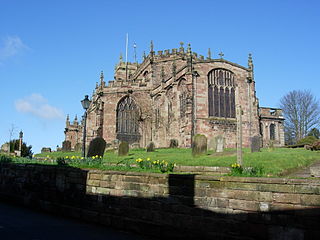
St Oswald's Church stands on the highest point in the market town of Malpas, Cheshire, England, on or near the site of a Norman motte and bailey castle. The church is recorded in the National Heritage List for England as a designated Grade I listed building and is recognised as being one of the best examples in Cheshire of a late 15th to early 16th-century church. It is an active Anglican parish church in the diocese of Chester, the archdeaconry of Chester and the deanery of Malpas. Its benefice is combined with those of St John, Threapwood, and Holy Trinity, Bickerton. Alec Clifton-Taylor includes it in his list of 'best' English parish churches.

Combermere Abbey is a former monastery, later a country house, near Burleydam, between Nantwich, Cheshire and Whitchurch in Shropshire, England, located within Cheshire and near the border with Shropshire. Initially Savigniac and later Cistercian, the abbey was founded in the 1130s by Hugh Malbank, Baron of Nantwich, and was also associated with Ranulf de Gernons, Earl of Chester. The abbey initially flourished, but by 1275 was sufficiently deeply in debt to be removed from the abbot's management. From that date until its dissolution in 1538, it was frequently in royal custody, and acquired a reputation for poor discipline and violent disputes with both lay people and other abbeys. It was the third largest monastic establishment in Cheshire, based on net income in 1535.
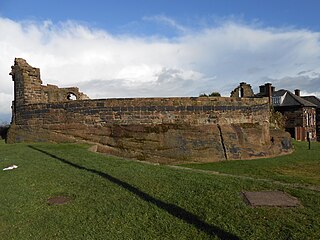
Halton Castle is a castle in the village of Halton, part of the town of Runcorn, Cheshire, England. The castle is on the top of Halton Hill, a sandstone prominence overlooking the village. The original building, a motte-and-bailey castle began in 1071, was replaced with the current sandstone castle in the 13th century. Building alterations continued until at least 1609, when the structure is recorded as in disrepair. The castle is recorded in the National Heritage List for England as a designated Grade I listed building, and a scheduled ancient monument.

Frodsham Castle was in the market town of Frodsham, Cheshire, England.
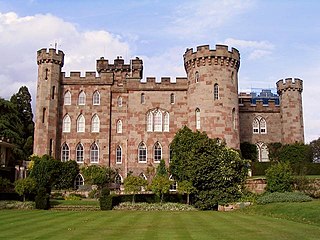
Cholmondeley Castle is a country house in the civil parish of Cholmondeley, Cheshire, England. Together with its adjacent formal gardens, it is surrounded by parkland. The site of the house has been a seat of the Cholmondeley family since the 12th century. The present house replaced a timber-framed hall nearby. It was built at the start of the 19th century for George Cholmondeley, 1st Marquess of Cholmondeley, who designed most of it himself in the form of a crenellated castle. After the death of the Marquess, the house was extended to designs by Robert Smirke to produce the building in its present form. The house is designated by English Heritage as a Grade II* listed building.

John Savage, 2nd Earl Rivers was a wealthy English nobleman, politician and Royalist from Cheshire.
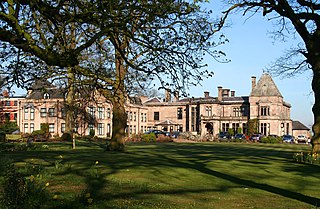
Rookery Hall is a Georgian style mansion located off the B5074 road near the village of Worleston in Cheshire, England. Dating originally from 1816 but extensively altered in the late 19th century, the hall is listed at grade II. Since 2001 Rookery Hall has been owned and managed by Julia Hands, Hand Picked Hotel Group. The Conference centre and Health Club and Spa were added in 2011.

Crewe Hall is a Jacobean mansion located near Crewe Green, east of Crewe, in Cheshire, England. Described by Nikolaus Pevsner as one of the two finest Jacobean houses in Cheshire, it is listed at grade I. Built in 1615–36 for Sir Randolph Crewe, it was one of the county's largest houses in the 17th century, and was said to have "brought London into Cheshire".
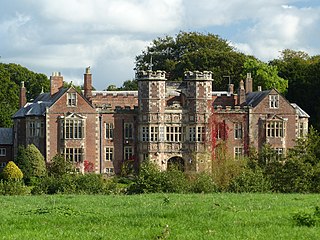
Brereton Hall is an Elizabethan prodigy house north of Brereton Green, next to St Oswald's Church in the civil parish of Brereton, Cheshire, England. It is recorded in the National Heritage List for England as a designated Grade I listed building. Brereton is not open to the public.
The Grade I listed buildings in Cheshire, excluding those in the city of Chester, total around 80. Almost half of these are churches that are contained in a separate list.

Runcorn Town Hall is in Heath Road, Runcorn, Cheshire, England. It is recorded in the National Heritage List for England as a designated Grade II listed building. It was originally built as Halton Grange, a mansion for Thomas Johnson, a local industrialist. After passing through the ownership of two other industrialists, it was purchased in the 1930s by Runcorn Urban District Council and converted into their offices. Since 1974, it has been the meeting place for Halton Borough Council.
Norcliffe Hall is a large house encompassing 20,254 square feet near the village of Styal, Cheshire, England. It stands to the west of the village and to the north of Styal Country Park. It was built in 1831 for Robert Hyde Greg, the owner of Quarry Bank Mill, and designed by the Lichfield architect Thomas Johnson. In 1860 a four-stage tower and a billiard room were added.

Runcorn is an industrial town in the borough of Halton, Cheshire, England. This list contains the 27 buildings that are recorded in the National Heritage List for England as designated listed buildings in the part of the borough lying to the south of the River Mersey outside the urban area of Runcorn. The area covered includes the villages of Clifton, Daresbury, Preston Brook, Preston on the Hill, and Moore. Three of the buildings in the area are classified as Grade II*, and the others are at Grade II; there are no buildings in Grade I. In the United Kingdom, the term listed building refers to a building or other structure officially designated as being of special architectural, historical, or cultural significance. These buildings are in three grades: Grade I consists of buildings of outstanding architectural or historical interest; Grade II* includes particularly significant buildings of more than local interest; Grade II consists of buildings of special architectural or historical interest. Buildings in England are listed by the Secretary of State for Culture, Media and Sport on recommendations provided by English Heritage, which also determines the grading.
Marbury Hall was a country house in Marbury, near Northwich, Cheshire, England. Several houses existed on the site from the 13th century, which formed the seat successively of the Marbury, Barry and Smith-Barry families, until 1932. An extensive collection of artwork and sculpture was housed at the hall from 1801 until the 1930s. The final house was extensively remodelled by Anthony Salvin in the 1850s.

Peel Hall is a country house near the village of Ashton Hayes, Cheshire, England. It is recorded in the National Heritage List for England as a designated Grade II* listed building. It was built as a mansion in 1637, but was much reduced in size by 1812, and was later used as a farmhouse. It is constructed in sandstone and has slate roofs. Its architectural style is Jacobean.
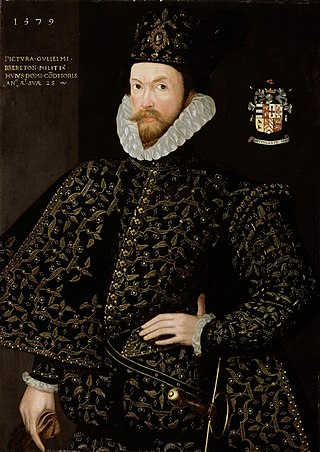
William Brereton, 1st Baron Brereton was an English politician who sat in the House of Commons at various times between 1597 and 1622. He was created a peer in the Peerage of Ireland in 1624 as Baron Brereton.
Hampton is a former civil parish, now in the parishes of No Man's Heath and District and Malpas, in Cheshire West and Chester, England. It contains four buildings that are recorded in the National Heritage List for England as designated listed buildings. One of these is listed at Grade II*, the middle grade, and the other three at the lowest grade, Grade II. The parish is entirely rural, and all the listed buildings are domestic, or related to farming.
There are over 9,000 Grade I listed buildings in England. This page is a list of these buildings in the unitary authority of Cheshire West and Chester.



















